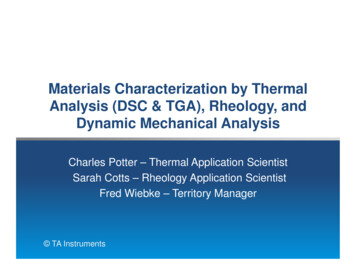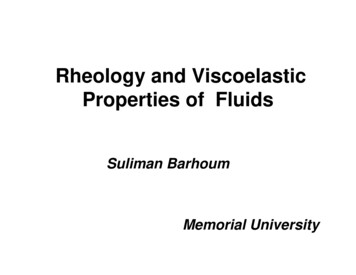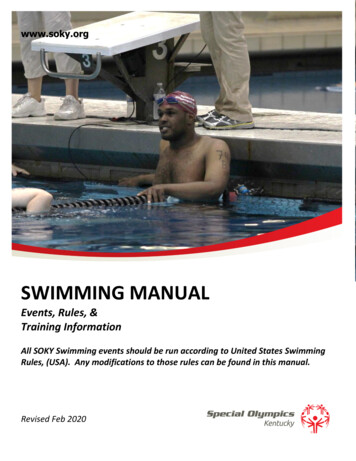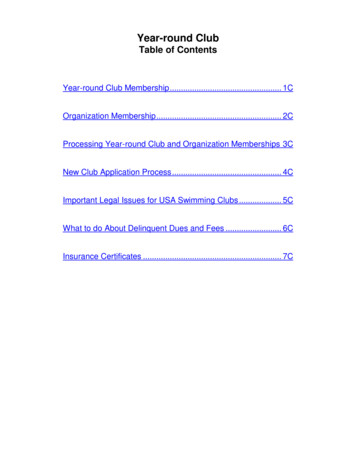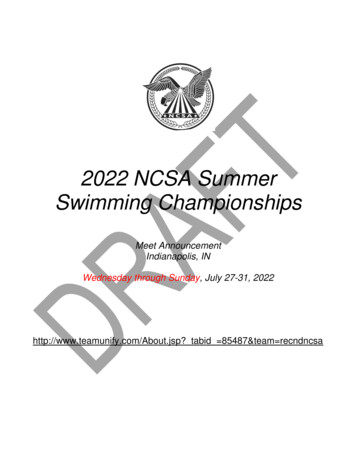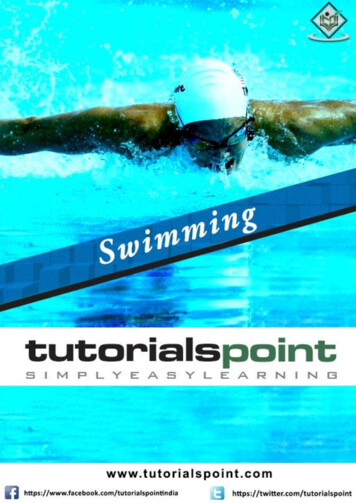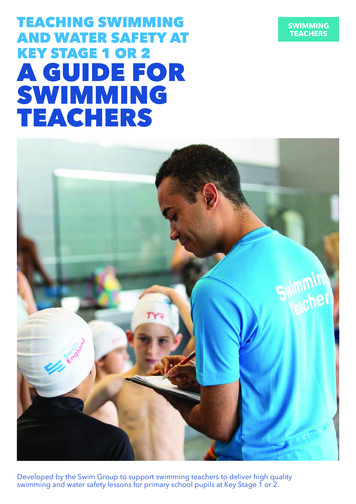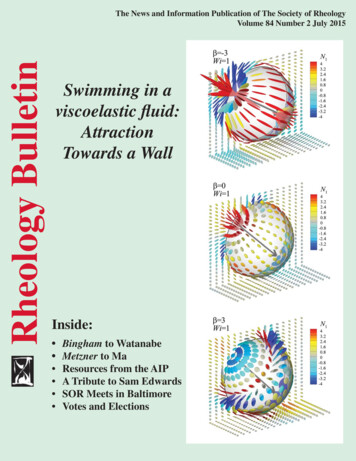
Transcription
Rheology BulletinThe News and Information Publication of The Society of RheologyVolume 84 Number 2 July 2015Swimming in aviscoelastic fluid:AttractionTowards a WallInside: Bingham to WatanabeMetzner to MaResources from the AIPA Tribute to Sam EdwardsSOR Meets in BaltimoreVotes and Elections
ExecutiveCommitteeTable of Contents(2013-2015)PresidentGregory B. McKennaVice PresidentGareth H. McKinleySecretaryAlbert CoTreasurerMontgomery T. ShawEditorRalph H. ColbyPast-PresidentA. Jeffrey GiacominMembers-at-LargeShelley AnnaDimitris VlassopoulosNorman J. Wagner2015 Bingham Award: Hiroshi Watanabe42015 Metzner Early Career Award: Anson Ma6Come to Baltimore! 87th Annual SOR Meeting9by Jai Pathak for the Local ArrangementsCommitteeCommunity resources available from theAmerican Institute of Physics10by Catherine O’Riordan, AIPVote to establish SOR Fellows14by Greg McKenna and Gareth McKinleyA Tribute to Professor Sir Sam Edwards16by Masao DoiAffordable SOR Short Courses in Baltimore18News/Business19Elections, Awards, News, ExComminutes, Treasurer's reportEvents Calendar28On the cover:Simulations shown reflect the hydrodynamics of low-Reynolds number swimmers, called "squirmers" near a wall in a viscoelasticfluid. The images show the snapshots of the conformation tensor and the first normal stress difference around a pusher (that generates thrust behind the body), neutral squirmer (that generates a symmetric flow field), and puller (that generates thrust in front ofthe body). Wi is the Weissenberg number, and is defined as the ratio of the second to the first squirming mode to distinguish threetypes of swimming mechanisms. The principal axis of each ellipsoid is aligned with the principal eigenvector of the conformationtensor and its length is scaled based on the associated eigenvalue. From Gao-Jin Li, Alireza Karimi, Arezoo M. Ardekani, workpresented at the 2014 SOR Meeting and published in Rheol. Acta, 53 (12), 911-926, 2014, used with permission.The Rheology Bulletin is the news and informationpublication of The Society of Rheology (SOR) and ispublished twice yearly in January and July. Subscription is free on membership in The Society of Rheology.Letters to the editor: rheology@aip.org.Serial Key Title: Rheology BulletinLC Control No.: 48011534Published for The Society of Rheology by AIP Publishing LLC(AIPP) a subsidiary of the American Institute of PhysicsISSN: 0035-4538 CODEN: RHBUAVCALL NUMBER: QC1 .R45The Rheology Bulletin is archived at www.rheology.org/sor/publications/rheology b/issues.htmand is also available through the iRheology app for iOS products.2Rheology Bulletin, 84(2) July 2015
CommitteesMembership Committee (2013-2015)Gordon ChristopherCari DutcherJason Maxey, chairCharles SchroederKelly SchultzPatrick SpicerEducation Committee (2013-2015)Michael BoehmJacinta ConradChris DimitriouMarie-Claude HeuzeyJonathan P. Rothstein, chairMaryam SepehrBingham Award Committee (2015)Lynden Archer (2013-2016)James Caruthers (2014-2017)Eric Furst (2014-2017)Marie-Claude Heuzey (2013-2016)Evelyne van Ruymbeke (2014-2017)Jay Schieber (2012-2015)Lynn Walker, chair (2012-2015)Ad hoc Committee on ICR (2013-2015)Gerald G. Fuller, chairAndrew M. KraynikJoão MaiaAd hoc Committee on Meeting App(s) (2015)Randy Ewoldt, chairMatthew ReichertMaryam SepehrAlbert Co (ex officio)Jason Maxey (ex officio)Metzner Award Committee (2015)Roger Bonnecaze (2013-2016)Victor Breedveld, chair (2012-2015)Morton Denn (2013-2016)George Petekidis (2014-2017)Nina Shapley (2012-2015)Meetings Policy Committee (2015)Andrew M. Kraynik, co-chairGareth McKinley, co-chair (VP)Albert Co (Secretary)Kalman Migler (2015 Local, 2016 (88th) Program)Rajesh Khare (2015 (87th) Program)Susan Muller (2015 (87th) Program)Don Baird (2016 (88th) Local)Anke Lindner (2016 (88th) Program)Nominating Committee (2015)Anne Grillet, chairDavid VenerusJan VermantJournal Publication Award Committee (2015)Shelley AnnaRoger BonnecazeRalph Colby, chairDimitris VlassopoulosAd hoc Committee on Electronic Publishingand Open Access Policies (2013-2015)Ralph Colby (ex officio)Jeffrey Giacomin (ex officio)Gareth H. McKinley, chairTom McLeishFaith A. MorrisonRoseanna ZiaAd hoc Financial Committee (2015)Anne M. Grillet, chairMontgomery T. Shaw (ex officio)Webmaster (2013-2015)Editor, Rheology Bulletin (2013-2015)Associate Editor for Business, Journal of Rheology (2013-2015)Director, International Outreach Program (2013-2015)Student Travel Grants Coordinator (2013-2015)Albert CoFaith A. MorrisonA. Jeffrey GiacominGerald G. FullerNorman WagnerAssociations with External Committees/Organizations:SOR Designee to AIP Governing Board (2013-2015)SOR Designee to AIPP Board of Managers (2013-2015)U.S. National Committee on Theoretical and Applied Mechanics (2013-2015)International Committee on Rheology (2012-2016)Faith A. MorrisonA. Jeffrey GiacominEric ShaqfehGerald G. FullerRheology Bulletin, 84(2) July 20153
2015 Bingham Medal Awardedto Hiroshi WatanabeProfile by Tim Lodge, University of MinnesotaThe 2015 Bingham Medal of The Society of Rheology isawarded to Hiroshi Watanabe of the Institute for Chemical Research, Kyoto University, Japan.In an independent career spanning threedecades, Hiroshi Watanabe has madea series of seminal contributions tothe molecular-level understanding ofthe rheology of polymer liquids, andin so doing advanced both theoreticaldescription and experimental practice.Above all, his ability to marry dielectric relaxation and rheometry on modelpolymers has provided a uniquelydetailed look at mechanisms of entangled polymer relaxation, and therebychallenged state-of-the-art theory atevery step.Hiroshi trained under Professor TadaoKotaka at Osaka University in the Department of Macromolecular Science, earning a Bachelor of Science in 1979, a Masters degree in 1981, anda Ph.D. in 1985. Following custom, as an exceptionalgraduate student he was promoted to Assistant Professor in the same laboratory. From April 1987 to March1989 Hiroshi came to the University of Minnesota as avisiting scientist, working with Matt Tirrell. In 1994 hewas called to the Institute for Chemical Research, KyotoUniversity, to become Associate Professor with thelegendary rheologist Professor Kunihiro Osaki. He succeeded Osaki as Professor in 2003, and he has remainedat the ICR ever since. From 2008-2012 he served asVice-Director of the entire Institute. His work has beenrecognized in many ways, including the Research Awardfrom the Society of Rheology, Japan, in 1994, the Awardfrom the Society of Polymer Science, Japan, in 2008 andFellowship in the American Physical Society (2005).Most recently he received the Award of the Society ofRheology, Japan (2012). Hiroshi has also served asan at-large member of the Executive Committee of theSociety of Rheology.Hiroshi’s first contributions to rheology were in theexploration of the linear and non-linear response ofordered block copolymer solutions (J. Rheol., 1984, 28,4393). These experiments of over thirty years’ vintage werereally ground-breaking; they preceded the popularization of this topic that was set off by measurements of theorder-disorder transition in the mid-1980s and that continues almost unabated today. It is a themeto which Hiroshi has returned throughouthis career; one may count upwards of50 papers on block copolymer rheologyfrom his group. Among the other recurring themes in Hiroshi’s overall oeuvreare polymer blends (both miscible andimmiscible), model star and comb polymers, and suspensions, gels, micelles,and liquid crystals. In each of these areashe has made substantial, incisive contributions, worthy of international recognition. Yet, they are all superseded by thetheme that has signified Hiroshi’s greatest contribution, alluded to above: hisunique insights into the mechanisms bywhich entangled polymers relax stress.Every polymer rheologist is now familiar with the pioneering reptation concept of Pierre-Gilles de Gennes, andhow Masao Doi and Sam Edwards built this into the coreof a molecular theory of polymer rheology. Although appealingly simple in conception, it soon became clear thatthis model had important deficiencies in its original form,and many additional processes have been considered(e.g. contour length fluctuations, constraint release, tubedilation, and orientational coupling, to mention some ofthe more prevalent). Over the ensuing decades the basicmodel has undergone considerable refinement, due to animpressive interplay of experiment and theory, to the extent that it is now acknowledged as a signature success ofcondensed matter theory. Much of the theoretical development has been motivated by the experimental approachthat Hiroshi exemplifies: his measurements have beencarefully crafted to test important assumptions, at themost fundamental level. This is where the use of dielectricrelaxation as a complement to rheometry (and to the lineardynamic moduli in particular) is so powerful.The ability of the linear stress relaxation modulus G(t)(and, equivalently, G’( ) and G”( )) to test moleculartheory is limited by the fact that G(t) is expressed as asum of exponential decays from the normal modes ofchain relaxation, each with a prescribed weighting factor.Rheology Bulletin, 84(2) July 2015
It is often possible to describe a given data set equallywell by different distributions of relaxation times.Dielectric relaxation senses the same mode spectrum,but with significantly different weighting factors, suchthat it is almost impossible for a model to describe theresults of both experiments on the same system by accident. And, by extension, when the model cannot quitedescribe bothexperiments, itis clear that thereis a deficiencythat needs to becorrected. Over 50years ago, WalterStockmayer firstclassified polymers that have amonomeric dipolemoment component along the chain axis as “Type A”and pointed out that the dipoles sum to give a net contribution that tracks the end-to-end vector. However, bysymmetry, all even-numbered modes do not contribute,so the experimental relaxation spectrum is quite differ(continues, page 26)Team HW Rheology, front, from left to right: Yukie Kajikawa, Akiko Uno, Eri Mishima,Ayoung Lee, Hiroshi Kawakita, Yumi Matsumiya, Motoaki Moriya, Shiro Katakura. Rear,from left to right: Shin-ichi Okada, Taro Kinoshita, Frederico Roschzttardz, Takashi Uneyama, Yuichi Masubuchi, Satoshi Tanaka, Hiroshi Watanabe, Takeshi Suzuki, Ryo Saitoh,and Quan Chen (who was also the designer of the Team HW Rheology uniforms).The two photos featured on this pagewere taken on the occasion of a sportstournament at the Institute for Chemical Research at Kyoto University. TheWatanabe lab members played tug-ofwar, which, as pointed out by HiroshiWatanabe, “is similar to an experimentof fully stretching a polymer chain (andincreasing the chain tension).” Thetension made by Team HW Rheologywas not strong enough, unfortunately,and they lost the game (“This outcomeis similar to chain withdrawal,” Watanabe notes.).Pulling for Team HW Rheology, fromleft to right: Kazushi Horio, ShinyaSuzuki, Kohji Sumida, Yohji Kawasaki,Natthida Rakkapao, Keisuke Hiramoto,Gen Higa, and Shiro Katakura.Rheology Bulletin, 84(2) July 20155
Metzner Early Career Award2015 Given to Anson MaProfile by Malcolm Mackley, Emeritus Professor,Cambridge University and Emeritus Fellow, RobinsonCollege Cambridge.Anson Ma was one of a number of very bright Ph.D.students that I was fortunate enough to supervise whenworking in the Department of Chemical Engineeringat Cambridge University. Not only did we have veryable UK undergraduates such as Gareth McKinley, whois now at the “other Cambridge” MIT, but there wasalso a tradition of ex Commonwealth Countries and theUSA offering prestigious scholarships to their most ablestudents in order to study at Cambridge. Anson had oneof these Scholarships from Hong Kong where he hadworked previously in the field of carbon nanotubes withPing Gao at the University of Science and Technology,Clearwater Bay. I naively thought carbon nanotubes(CNTs) were similar to polymers, and so it seemed asensible and at the time fashionable topic to work on;also Anson had “Carbon Nanotubes written all the wayacross his forehead.” CNTs are challenging materials notleast from a rheological point of view; however Anson,with his meticulous approach to science and rheology,made sense of difficult experiments. Working togetherwith Paco Chinesta, who is now at Ecole Centrale desNantes, Anson was the glue that made the link betweenexperiment and some high level suspension rheological modelling. Anson was also the person who createdwonderful videos, and I encourage you all to view hisCNT Helical Banding movie that you can find at: ell/.Whilst carrying out his Ph.D., Anson founded with thehelp of others a very successful Cambridge CNT Societywhich brought together CNT activity from a number ofseparate different Cambridge Departments including,Engineering, Chemical Engineering, Material Science,Physics and Chemistry. This was a significant achievement for a Ph.D. student and resulted in the Ph.D.sorganizing, on their own initiative, a very successfulInternational Conference on CNTs held at ChurchillCollege.After obtaining his Ph.D. in 2009, Anson went on to workwith Matteo Pasquali at Houston where he extended hisCNT interests studying both CNT super acid solutionspinning and dip coating. In 2011 he was appointed asan Assistant Professor at the University of Connecticut,and since then he has built up his own group that appliesrheology principles to a wide range of systems includingenhanced colloidal stability of rod-like particles, bloodflow, and the application of ink jet processing to biocell application. Anson is also building on the legacy ofrheology created by Monty Shaw at UConn in organizingrheology workshops and outreach programs on rheologytopics together with developing a “rheological taste” forice cream from collaborative projects with the UConncreamery.Whilst on a USA lecture tour in the 1980s, I met ArthurMetzner at Delaware where Arthur and his wife wereperfect hosts to our visit. Arthur was a true gentleman,precise and deeply interested in rheology. I hope he wouldhave approved of Anson as a very worthy recipient ofhis award. Anson certainly has many of the qualities thatArthur possessed.The SOR Early Career Award, established in 2009, is named for Art Metzner, distinguishedrheologist, university professor, Editor of the Journal of Rheology, and 1977 Bingham medalist.For a list of all recipients and the criteria of the Metzner award, see www.rheology.org.6Rheology Bulletin, 84(2) July 2015
Rheology Bulletin, 84(2) July 20157
Discover MoreRheometer VersatilityThe Discovery Hybrid Rheometer combines the most accurate rheologicalmeasurements with the most extensive line of easy-to-use environmental systemsand accessories, ensuring you have the right rheometer for every job.AccessoriesEnvironmental Systemst "YJBM %." 5FOTJPO 1PJOU #FOEJOH Cantilever and Compressiont 5SJCPMPHZt .BHOFUPSIFPMPHZt .JDSPTDPQZ JODMVEJOH PVOUFS 3PUBUJPOt *OUFSGBDJBMt 4NBMM "OHMF -JHIU 4DBUUFSJOHt &MFDUSPSIFPMPHZt %JFMFDUSJDt 67 VSJOHt &YUFOTJPOBM 7JTDPTJUZt 1SFTTVSF FMMt 4UBSDI 1BTUJOH FMMt 4UBOEBSE 1FMUJFS 1MBUFt 4UFQQFE 1FMUJFS 1MBUFt %JTQPTBCMF 1FMUJFS 1MBUFt &YUFOEFE 3BOHF 1FMUJFS 1MBUFt 1FMUJFS PODFOUSJD ZMJOEFSTt 6QQFS )FBUFE 1MBUFt &5 0WFOt &MFDUSJDBMMZ )FBUFE 1MBUFT8www.tainstruments.comRheology Bulletin, 84(2) July 2015
(Used with permission of the Hyatt Regency)Come to Baltimore!Jai A. Pathak, on behalf of the Local Arrangements Committee:Kalman Migler, Jai Pathak, Chris White, Steven Hudson and Srinivasa RaghavanThis fall, rheologists from far and wide will reconvene in Baltimore, Maryland, for the 87th Annual Meeting of the Society of Rheology. The meeting will be held 11-15 October at the Hyatt Regency Hotel, Inner Harbor (pictured above).Baltimore Inner Harbor is located on the Patapsco River, which drains into the Chesapeake Bay. The inner harbor areaoffers much to visitors, including the famed National Aquarium, one of the top-rated aquariums in the U.S., and theMaryland Science Center. Those interested in visiting the Aquarium are encouraged to buy tickets online ahead of time,as it is a favorite destination of both tourists and locals. A reception will also be held at the National Aquarium (seedetails below). Plenty of opportunities abound for fine dining, especially seafood, sightseeing, and cruises. Baltimore isa city with tremendous historical significance dating back to the pre-colonial and colonial times. The War of 1812 wasfought between U.S. and Britain at Fort McHenry, near Baltimore, which is a must-see destination for history buffs.The American national anthem, the Star Spangled Banner was written by Francis Scott Key during the War of 1812. Hepenned it as a patriotic song The Defense of Fort McHenry, and the U.S. Congress eventually passed legislation to makeit the official national anthem in 1931.The meeting will offer high quality scientific programming and will be well attended, with 300 abstracts on the programfor podium presentations. There will be ten thematic sessions and a poster session; the poster session will also havestudent/post-doc poster competitions. The plenary lectures will be given by Mark Robbins (John Hopkins University,Department of Physics and Astronomy), Jan Vermant (ETH Zürich, Department of Materials) and the 2015 BinghamMedalist Hiroshi Watanabe (Institute for Chemical Research, Kyoto University). A presentation will also begiven by the 2015 Metzner awardee, Anson Ma (Universityof Connecticut). Two short courses will be offered on theweekend before the meeting (10-11 October): Active andPassive Microrheology (two-day course, instructors EricFurst (University of Delaware) and Roseanna Zia (CornellUniversity)) and Just-in-Time Beginning Rheology (dayand-a-half course, instructors Faith Morrison (MichiganTechnological University), and Ronald Larson (Universityof Michigan)).The Baltimore meeting will feature lively social program(continues page 27)Rheology Bulletin, 84(2) July 2015(Used with permission of the National Aquarium)Baltimore is well connected to destinations in the the U.S. by Justice Thurgood Marshall International Airport, whichalso offers some nonstop flights to Europe. Philadelphia International Airport offers additional options for flights toEurope. Baltimore is served by Amtrak trains and is also on major highways, Interstate 83 and Interstate 95, whichspans the East Coast of the country. Baltimore is also a major seaport, and many cruise ships depart from the port nearthe inner harbor.9
Community resources available from theAmerican Institute of PhysicsCatherine O’Riordan,Vice President, Physics ResourcesAmerican Institute of PhysicsThe Society of Rheology is a valued member of theAmerican Institute of Physics (AIP) federation ofphysical science societies. Each Member Society hasa slightly different relationship with AIP—dependingon a society’s needs and scope—but for all societies,AIP adds value to the collective membership. The mostvisible benefit perhaps is Physics Today magazine, butthere are many other waysin which AIP supportsMember Societies likeSOR, physical scientists,and even the general public. These programs uniformly tie in to our sharedmissions of advancing andpromoting science.First, some history: SORwas one of the five physical sciences societies that cametogether to create AIP in 1931. AIP was conceived primarily as a publishing-services provider and consortiumof publishing societies in the physical sciences. Sinceit was created, the Institute has served as the publisherof the Journal of Rheology (formerly the Transactionsof The Society of Rheology). In the decades that followed, the AIP federation grew, and the Institute beganto provide other services to its Member Societies andthe scientific community. Physics Today, for example,was launched in 1948, the Society of Physics Students in1950, and the History Programs in 1962.belonging to the AIP federation— a total of120,000 scientists, engineers, and students—receive Physics Today as a benefit, both inprint and electronically. In addition to themonthly edition, Physics Today posts newcontent daily on www.physicstoday.org. Dailyitems include news briefs, blogs, columns, andtargeted information for those interested in industry. Physics Today is also active on Twitter and hosts aFacebook page with over 2.2 million “likes”. Interesting,shareable news items are posted three-to-four times perday.AIP’s Government Relations division has publishedFYI: The AIP Bulletin of Science Policy News for morethan 25 years. The audience includes leaders and staff inUS Federal agencies, Congress, embassies, and the WhiteHouse, as well as scientists and students interested in public policy. The AIP Bulletin is distributed by email andcovers policy activities in Congress and other organizations that affect the physical sciences. All news items arearchived on the website at www.aip.org/fyi.Today, AIP supports over 22 million of outreach andcommunication programs. Revenue sources for theseThe Statistical Research Center (SRC) collects data onactivities are varied and include surplus revenue fromeducation and employment in physics, astronomy, and alits publishing activities (now under AIP Publishing,a wholly owned subsidiary), grants,contracts, contribution, dues, andSign up for free AIP E-Updates and News:investment income. Below I highlightsome of the programs that may be ofPhysics Today: www.aip.org/pt/pt alertinterest to SOR members. To sign upFYI/Science Policy: www.aip.org/fyi/fyi-subscribe.htmlfor e-alerts for these programs, see theStatistical Research: www.aip.org/statistics/e updatescall-out box on this page.Inside Science: www.insidescience.org/isns alertPhysics Today, AIP’s flagship magazine, takes a broad view to highlightexciting research across the physicalsciences. All members of the societies10Science news releases: send request to media@aip.orgHistory Center newsletter: www.aip.org/history-programs/history newsSigma Pi Sigma Radiations: www.sigmapisigma.org/radiations/index.htmRheology Bulletin, 84(2) July 2015
Ready for all MCR accessoriesAntonPaaradMCR 702Tcan be used with all single-motorMCR accessories - as well as a variety ofthirdspecific T measuring cells.Rheology Bulletin, 84(2) July 2015One rheometer. Two drives. All possibilities.www.anton-paar.com/twindrive11
lied fields. Reports present data on areas such as underrepresented minorities in physics and engineering fields,starting salaries for STEM education graduates, careerpaths for graduates, and studies of careers and resourcesfor scientists around the globe. You can sign up forSRC’s e-Updates to keep informed about newly releasedreports; subscriptions are free and can be catered to yourspecific areas of interest.One AIP goal is to disseminate information about thephysical sciences to the general public. To accomplishthis, AIP produces Inside Science, a news wire serviceand video program for the general public. Topics covera very broad range of science, from quantum math toneuroscience, with stories as diverse as “Spacetime Maybe a Slippery Fluid” to “Sewage Bacteria Reveal Cities'Obesity Rates.”AIP also offers Media Services directly to several ofits Member Societies. The media services team offerseverything from media training to single public relationsevents or multi-year media campaigns that raise the profile of scientific societies and their members, meetings,and journals. We have had tremendous success alreadybuilding awareness of the closely related field of fluiddynamics through our efforts promoting papers in ourjournal Physics of Fluids and research at the AmericanPhysical Society Division of Fluid Dynamics annualmeeting every year.Beginning in the late 1950’s, many scientists recognized a need to preserve and disseminate the historyof the physical sciences. Member Societies supportedAIP’s creation of the Niels Bohr Library and Archives(NBLA) and launch the Center for the History ofPhysics. Today, the Archives hosts historical papersfrom each of the ten Member Societies, including SOR.In 2013, AIP and SOR arranged for the scanning of theRheology Bulletin archive, to be placed online. TheRheology Bulletins are part of the Society of Rheologymiscellaneous publications collection within the NBLA:www.aip.org/history/ead/20110348.html.Many of AIP’s history resources are available online, including the large collection of photographs in the EmilioSegrè Visual Archives (over 30,000 are digitized andlow resolution versions are freely available for personaluse), over 1000 oral histories (also digitized and searchable on-line), and a number of web exhibits that examine critical issues and luminary figures, including MarieCurie, Albert Einstein, and global warming, that enticemillions of viewers each year. To help readers keep upwith all this, AIP regularly delivers the Center for History of Physics Newsletter in print or electronically.AIP is home to the Society of Physics Students (SPS)and the physics honor society Sigma Pi Sigma. SPS isa community for physics undergraduates and their mentors, with more than 4,000 members and 700 chaptersnationwide, and several international chapters. SPS andSOR have a membership agreement whereby studentscan choose to join SOR for free when they sign up forSPS. Presently, more than 50 undergraduates are takingadvantage of this benefit and learning more about theSOR community. Sigma Pi Sigma honors outstandingscholarship in physics, encourages interest in the field,and promotes an attitude of service among its 42,000members towards the entire physics community and thepublic.AIP and SOR enjoy a fruitful relationship in the area ofIndustrial Outreach. In recent years, we have workedtogether to hold industrial outreach events (panels/receptions) at SOR annual meetings. The Rheologyin the Real World forum at the 2014 SOR meeting inPhiladelphia in October 2014 featured speakers fromthe Dow Chemical Company, NIST, the University ofQueensland, Medimmune, and Procter & Gamble. Thestanding-room-only audience was filled with studentseager to learn from SOR members working in industryand about industrial applications of rheology. AIPalso holds Industrial Physics Forums, nominallyonce yearly, often in conjunction with MemberSocieties. Forums are built around a theme, withseveral invited sessions. The last Forum was thesecond held outside the US—in Campinas, Brazil—and looked into Capacity Building for IndustrialPhysics in Emerging Economies.SOR members interested in any of the programsabove are welcome to sign up for any number ofAIP’s e-alerts and newsletters. The information isyours, and it’s all free. See the call-out box on page10 for how to sign up.Participants in the 2014 Rheology in the Real World forum in Philadelphia, front,left to right Seth Lindberg, Catheryn Jackson, Michael Boehm, Kalman Migler, JaiPathak; rear Gerry Fuller, Matthew Reichert, Maryam Sepehr, and Amy Shen.12Rheology Bulletin, 84(2) July 2015
JOURNAL OF RHEOLOGYCALL FOR PAPERS AND EXPRESSIONS OF INTENTSpecial Issue on Shear BandingEditor: Prof. Ralph H. Colby, Penn State UniversityGuest Editor: Prof. Suzanne Fielding, Durham UniversityExpressions of intent to submit a paper are invited for a special issue ofthe Journal of Rheology. Scheduled for publication in spring/summer2016, this issue will focus on shear banding in complex fluids, withparticular emphasis on the dynamics of shear-banded flows and onshear banding in time-dependent flow protocols. Papers concerningwall slip and edge fracture as they pertain to issues of shear banding arealso encouraged. Submissions are welcome from experimentalists andtheorists, and from all parts of the soft matter and rheology communities:from those concerned with yielding in disordered soft ‘glassy’ materials, tothose with interests in shear banding in polymers and wormlike micelles.EXPRESSION OF INTENTIf you plan to submit a paper, expressions of intent are encouraged at your earliest opportunity, as it would beuseful for us to have a list of potential contributions prior the submission deadline.QPlease inform Ms. Marcy Fowler, Editorial Assistant, by E-mail JOR-EditorialOffice@aip.orgQPlease use INTENT - Special Issue/Shear Banding in the Subject header of your message.QPlease indicate the area you propose to address in your manuscript.QPlease include contact author’s name, institution and email, and those of known or proposed co-authors.SUBMISSION OF PAPERSONLINE AT: http://jor.peerx-press.orgSELECT: Special Issue/Shear Banding when completing submission data online.DEADLINE FOR SUBMISSIONS: September 15, 2015Early submission is strongly encouraged.Rheology Bulletin, 84(2) July 2015Journalofrheology.org13
Sent to the membership by email 31 May 2015Dear Membership of the SOR:The SOR Executive Committee, pursuant to Article VIII of the Rules of the Society, has proposed the creation of astatus of Fellow of the Society. The membership is being asked to vote on the Rules change listed below that wouldcreate the status of Fellow of the Society. The purpose of the creation of the Fellowship status is to recognize membersof The Society of Rheology who have a history of distinguished scientific achievement, a significant technological accomplishment, and/or outstanding scholarship in the field of Rheology. A record of continued service to the Society isalso an important component to Fellowship status. SOR members in good standing for at least 8 years are eligible forthe award.We have proposed a straight-forward Nomination Procedure for Fellows should the ballot measure pass:The nomination packet should include (1) a letter of no more than two pages describing the nominee’s scientific accomplishments and service contributions i
American Institute of Physics by Catherine O'Riordan, AIP Vote to establish SOR Fellows 14 by Greg McKenna and Gareth McKinley A Tribute to Professor Sir Sam Edwards 16 by Masao Doi Affordable SOR Short Courses in Baltimore 18 News/Business 19 Elections, Awards, News, ExCom
